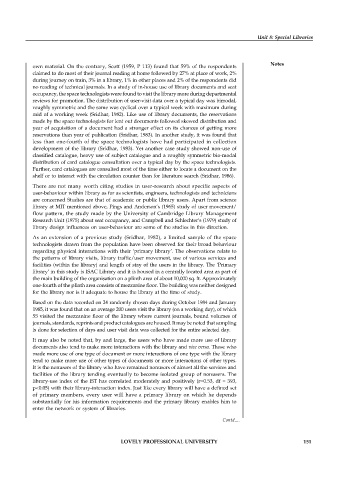Page 156 - DLIS001_FOUNDATION_OF_LIBRARY_AND_INFORMATION_SCIENCE
P. 156
Unit 8: Special Libraries
Notes
own material. On the contrary, Scott (1959, P 113) found that 59% of the respondents
claimed to do most of their journal reading at home followed by 27% at place of work, 2%
during journey on train, 3% in a library, 1% in other places and 2% of the respondents did
no reading of technical journals. In a study of in-house use of library documents and seat
occupancy, the space technologists were found to visit the library more during departmental
reviews for promotion. The distribution of user-visit data over a typical day was bimodal,
roughly symmetric and the same was cyclical over a typical week with maximum during
mid of a working week (Sridhar, 1982). Like use of library documents, the reservations
made by the space technologists for lent out documents followed skewed distribution and
year of acquisition of a document had a stronger effect on its chances of getting more
reservations than year of publication (Sridhar, 1983). In another study, it was found that
less than one-fourth of the space technologists have had participated in collection
development of the library (Sridhar, 1983). Yet another case study showed non-use of
classified catalogue, heavy use of subject catalogue and a roughly symmetric bio-modal
distribution of card catalogue consultation over a typical day by the space technologists.
Further, card catalogues are consulted most of the time either to locate a document on the
shelf or to interact with the circulation counter than for literature search (Sridhar, 1986).
There are not many worth citing studies in user-research about specific aspects of
user-behaviour within library as far as scientists, engineers, technologists and technicians
are concerned Studies are that of academic or public library users. Apart from science
library at MIT mentioned above, Pings and Anderson’s (1965) study of user movement/
flow pattern, the study made by the University of Cambridge Library Management
Research Unit (1975) about seat occupancy, and Campbell and Schlechter’s (1979) study of
library design influences on user-behaviour are some of the studies in this direction.
As an extension of a previous study (Sridhar, 1982), a limited sample of the space
technologists drawn from the population have been observed for their broad behaviour
regarding physical interactions with their ‘primary library’. The observations relate to
the patterns of library visits, library traffic/user movement, use of various services and
facilities (within the library) and length of stay of the users in the library. The ‘Primary
library’ in this study is ISAC Library and it is housed in a centrally located area as part of
the main building of the organisation on a plinth area of about 10,000 sq. ft. Approximately
one-fourth of the plinth area consists of mezzanine floor. The building was neither designed
for the library nor is it adequate to house the library at the time of study.
Based on the data recorded on 24 randomly chosen days during October 1984 and January
1985, it was found that on an average 200 users visit the library (on a working day), of which
55 visited the mezzanine floor of the library where current journals, bound volumes of
journals, standards, reprints and product catalogues are housed. It may be noted that sampling
is done for selection of days and user visit data was collected for the entire selected day.
It may also be noted that, by and large, the users who have made more use of library
documents also tend to make more interactions with the library and vice versa. Those who
made more use of one type of document or more interactions of one type with the library
tend to make more use of other types of documents or more interactions of other types.
It is the nonusers of the library who have remained nonusers of almost all the services and
facilities of the library tending eventually to become isolated group of nonusers. The
library-use index of the IST has correlated moderately and positively (r=0.53, df = 393,
p<0.05) with their library-interaction index. Just like every library will have a defined set
of primary members, every user will have a primary library on which he depends
substantially for his information requirements and the primary library enables him to
enter the network or system of libraries.
Contd....
LOVELY PROFESSIONAL UNIVERSITY 151

